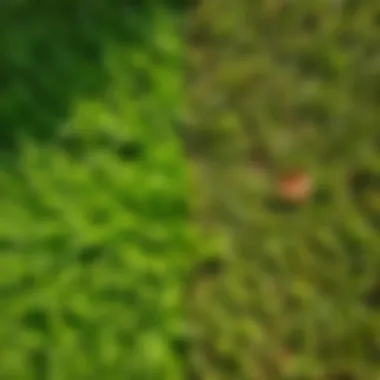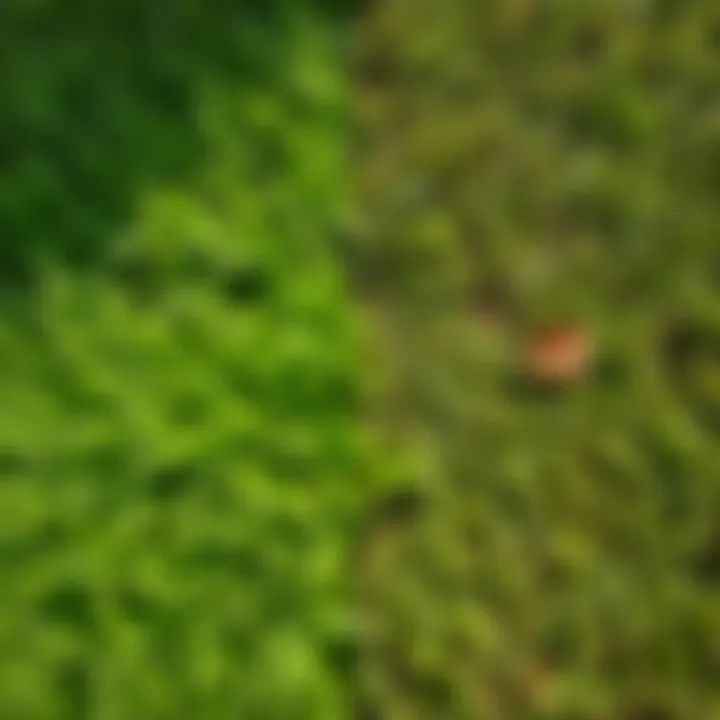Effective Solutions for Lawn Urine Spots


Intro
Lush lawns often represent the epitome of home aesthetics, inviting a sense of pride for owners and a haven for pets. However, one persistent issue can turn that green paradise into a patchy landscape: urine spots. These unsightly blemishes are not just an eyesore; they signify a deeper struggle between pets and plant life. Understanding the root causes of these issues and how to tackle them effectively can make all the difference in maintaining a healthy lawn that is both inviting and resilient.
Not all lawns are created equal, and a one-size-fits-all approach won’t yield the results homeowners desire. Instead, this guide sheds light on tailored strategies, showcasing the ins and outs of reversing damage caused by pet urine, from soil management to the selection of grass types that withstand these challenges. Let’s set the stage for a journey that intertwines agriculture trends, sustainability practices, and effective gardening techniques—all to foster a green space that flourishes regardless of our furry friends' habits.
Latest Trends in Agriculture
Overview of Current Trends
Agriculture, particularly in the realm of lawn care and gardening, is seeing a shift towards sustainable practices. With the need for environmental responsibility more pronounced than ever, homeowners are seeking ways to keep their lawns healthy without relying solely on artificial fertilizers. Techniques such as organic lawncare, using natural fertilizers made from plant and animal byproducts, are becoming more mainstream. This makes it easier to balance maintaining a vibrant lawn while being mindful of ecological impacts.
Additionally, urban farming and micro-gardening are on the rise. More individuals, even in densely populated areas, strive to create green spaces. This trend encourages a greater understanding of local ecosystems and nurturing plant health in confined spaces, proving that lush grass isn’t just for sprawling estates.
Impact of Technology on Farming Practices
Innovative technology also plays a pivotal role in shaping effective lawn care. Tools like soil moisture sensors and automated irrigation systems help homeowners monitor their lawn's needs precisely, reducing water waste and enabling targeted treatments for issues like urine spots. Moreover, data analytics can assist in identifying the right grass varieties suited to individual environmental conditions, allowing for a customized approach based on specific climate and soil types.
Sustainable Practices: Towards a Greener Future
Importance of Sustainability in Agriculture
The conversation about sustainability goes hand-in-hand with the care of your lawn. As we acknowledge the responsibility we have toward our environment, focusing on sustainable practices can lead to healthier soils, stronger grass, and a diminished chance of urine spot formation. Keeping chemical use to a minimum and adopting more eco-friendly practices can contribute to an overall healthier ecosystem.
Methods for Sustainable Farming
- Using Natural Amendments: Consider composting kitchen scraps and yard waste to create rich organic matter that will nourish the soil.
- Crop Rotation: This practice can help prevent the depletion of nutrients while promoting a diverse microbial community in your soil, enhancing grass health.
- Mulching: Applying organic mulch can retain soil moisture, regulate temperature, and prevent weed growth, which may elevate competition for nutrients in high-urine areas.
The key to successful lawn management lies not just in remedying present issues but establishing a long-term health plan that accounts for potential challenges, like urine spots from playful pets.
Gardening Techniques and Tips
Essential Gardening Tools and Equipment
To tackle the nuances of combating urine spots effectively, a few essential tools can make life easier:
- Soil Tester: Identify nutrient deficiencies or pH imbalances.
- Hand Trowel: Perfect for small areas when applying amendments or reseeding affected patches.
- Spray Bottle: Useful for applying natural remedies or fertilizers in a targeted manner.
- Garden Rake: Smoothens soil and mixes amendments effectively.
Seasonal Gardening Practices
Different seasons bring about unique challenges in lawn care.
- Spring: Ideal for seeding and laying down fertilizer to promote healthy growth.
- Summer: Focus on watering techniques and mulch application to retain moisture.
- Fall: Perfect time to aerate and prepare the lawn for winter, ensuring it is ready for the subsequent growth cycle.
- Winter: Practice preventive measures by monitoring high-traffic areas to avoid compaction damage.
With proactive care and attention to the specific needs of your lawn, it is possible to reverse the effects of pet urine and cultivate a verdant expanse that is both beautiful and robust.
Understanding the Problem
Addressing urine spots in lawns is essential for homeowners and gardening enthusiasts alike. The impact of pet waste on grass health can lead to unsightly patches and may affect the overall aesthetic of the outdoor space. Understanding the problem is not merely about recognizing these spots, but grasping the broader implications of pet urine on lawn vitality.
The significance of this awareness is twofold. First, it allows homeowners to take proactive measures before damage escalates. By recognizing early signs of urine damage, such as yellowing grass or patchy areas, one can formulate an effective response. Second, it prepares one to regroup and restore affected areas with a well-informed approach.
When a dog or cat relieves itself outside, the concentrated source of nitrogen and salts in urine can wreak havoc on grass. A healthy lawn thrives on a delicate balance of nutrients, and an influx from urine can tip that balance, leading to harmful consequences. Not only does this issue pose visual concerns, but it can also impact the ecosystem of the lawn. For instance, while nitrogen is vital for plant growth, excessive amounts can lead to burning and stress on the surrounding flora.
Furthermore, addressing this issue requires recognizing the social aspect of lawn care. With so many pet lovers in urban areas, the problem becomes a communal challenge, prompting discussions on methods for maintaining both lawns and pet care practices. As such, understanding the problems presented by urine spots cannot be understated; it creates an informed community, ready to tackle issues head-on and share solutions that benefit all.
"An ounce of prevention is worth a pound of cure," and this holds true for lawn care as well.
The Impact of Urine on Grass
The direct impact of urine on grass is multifaceted and complex. When familiar pets urinate on a lawn, the consequences can vary based on several factors including the urine concentration, the type of grass, and the soil conditions. Often, the immediate effect is the yellowing of grass where urine hits the ground. This yellowing can swiftly develop into larger dead patches if left unaddressed.
Excessive nitrogen in the urine can initially spur growth, causing a temporary burst of lushness. However, this growth soon turns to stress as the grass cannot cope with the sudden influx of nutrients. Added salt content can further worsen the situation, leading to dehydration of the plant cells and compromising their structural integrity.
The specific grass types will react differently to urine exposure as well. Some varieties may be more resilient, displaying quicker recovery, while others may struggle to bounce back, resulting in long-lasting damage. The circle of life in a lawn can be disrupted, prompting owners to reevaluate their grass choices to foster a more durable ecosystem.
Common Symptoms of Urine Damage
Recognizing the signs of urine damage in grass can be quite straightforward, provided you know what to look for. Common symptoms include:
- Yellow patches: The most obvious sign; these patches often appear where pets frequently urinate.
- Burnt tips: Grass blades may appear burnt or crispy, signaling cellular damage from high chemical concentrations.
- Stunted growth: Areas affected by urine may exhibit slower growth compared to healthier sections, as the stress inhibits normal development.
- Area size: If you notice larger patches of brown or yellow grass, it may indicate that the animal favors certain spots, which can lead to a more pronounced impact.
Understanding these signs is critical, as early identification allows for quicker intervention. Being vigilant about these symptoms helps in maintaining the trajectory of lawn health and ensures a beautiful outdoor space, ready for pet play and relaxation.
Chemical Composition of Urine


Understanding the chemical make-up of urine is paramount for grasping its impact on lawn health. Pet urine consists primarily of water but is also rich in nitrogen, urea, creatinine, and various salts. These elements can significantly affect grass vitality, leading to issues like those unsightly brown patches that can turn a lush lawn into a parched wasteland. By becoming familiar with these components, homeowners can adopt more effective strategies to mitigate the negative effects of urine on their landscaping.
Understanding Nitrogen Levels
Nitrogen is the heavyweight in urine's composition, often touted as a vital nutrient for plant growth. While it's an essential ingredient in fertilizers, an excess of this nutrient can spell disaster for grass. When pets unleash their business on your lawn, the concentrated nitrogen levels can overwhelm the grass. Here, the nitrogen converts into ammonium and raises the toxicity in the soil, effectively scorching the grass. It’s a classic case of too much of a good thing.
- Signs of Excess Nitrogen:
- Yellow and brown patches
- Stunted growth
- Unkempt appearance
Striking a balance is necessary. One way to manage nitrogen levels is through a practice known as dilution. By watering the affected area immediately after your pet goes, you can lessen the concentration of nitrogen and help the grass recover.
Other Compounds in Urine
Aside from nitrogen, urine contains a cocktail of other compounds that can influence lawn health. Urea, for instance, is a significant nitrogen source but can lead to low pH in the soil. When urea breaks down, it releases ammonia, leading to that notorious burn effect.
Other components include:
- Creatinine: A byproduct of muscle metabolism that adds to soil’s nutrient complexity but can also contribute to mowing mishaps if it's overly concentrated.
- Salts: These can accumulate over time and create conditions less than ideal for grass to thrive.
By understanding these compounds, homeowners can make more educated choices regarding lawn care and pet management. A well-rounded approach incorporating these insights can improve lawn resilience and create a more harmonious outdoor environment.
"Adjustment in fertilization and watering can minimize urine spots, providing a better long-term environment for your lawn."
In summary, decoding the chemical composition of urine, especially regarding nitrogen and other compounds, offers invaluable insight into how to approach lawn care when pets are involved and keep that grass green and healthy.
Identifying Damage Severity
Understanding the severity of damage to your lawn due to pet urine is not just a cosmetic concern; it’s a crucial part of effective lawn management. Identifying damage severity allows homeowners and garden enthusiasts to apply the right remediation strategies. Ignoring the signs can lead to further deterioration of grass health and soil integrity. By gauging the extent of damage, you can tailor your approach to rejuvenate your lawn efficiently and effectively.
Assessing Grass Health
Assessing grass health is a key factor in identifying urine damage. Evaluating the color, texture, and overall vigor of your lawn can provide significant insights into the condition of your grass. Healthy grass typically exhibits a rich green hue and a robust structure.
When you notice yellowish spots or areas where grass seems to struggle, it is often a signal that urine is affecting the grass directly. This is particularly evident in scenarios where the concentration of nitrogen in the urine is excessive, outpacing the grass's ability to cope. Moreover, when examining your lawn, take note of the following aspects:
- Grass Color: Look for differences in shade across your lawn. Dark green patches indicate healthy grass, while tan or yellow patches reveal areas suffering from urine impact.
- Grass Density: Is it sparse in certain areas? Thinning grass can signal nutrient overload or a depletion of essential soil nutrients.
- Root Health: Gently pull a few blades of grass to inspect root health. Strong roots are typically white and firm. Rotted or discolored roots suggest a health issue that might stem from soil quality or overapplication of nitrogen.
Investing time in assessing these characteristics can save you both time and resources while restoring your lawn to its previous glory.
Evaluating Soil Integrity
Evaluating the integrity of your soil is another vital aspect when identifying damage severity from pet urine. Soil is the backbone of your lawn's health, and understanding its composition is key to determining its capacity to support grass growth.
Begin by examining your soil structure. A well-aerated soil is crumbly and drains water effectively, whereas compacted or heavy clay soils might retain excess moisture and nutrients, leading to issues. Here are practical steps you can follow to evaluate your soil:
- Texture and Composition: Take a handful of soil and feel its texture. Sandy soils drain well but may lack nutrients, while clay soils might hold water but can become dense and unyielding. Knowing the type of soil you have will guide your fertilization and watering strategies.
- pH Levels: Testing your soil's pH is crucial. If it tilts heavily towards acidity due to nutrient buildup from urine, it can harm grass health. Aim for a pH around 6.0 to 7.0 for optimal grass growth.
- Nutrient Analysis: A soil test can uncover the levels of key nutrients. If nitrogen is excessively high, consider balancing it with appropriate amendments or organic matter to restore integrity.
By regularly assessing grass health and soil integrity, homeowners can take a focused approach to lawn care, leading to a healthier, greener outdoor space.
"A healthy lawn is like a symphony; every blade and every root plays a crucial note."
Arming yourself with knowledge about these aspects equips you to tackle urine damage effectively. This proactive approach ensures that your lawn not only recovers but thrives in the long run.
Immediate Remedial Actions
Addressing the spots left by pet urine isn't just about aesthetics; it affects the overall health of your lawn. These immediate actions can significantly alleviate the damage and provide a quick recovery path for your grass. Knowing how to respond to the issue as soon as you notice it is crucial. Delaying could lead to more extensive damage, increasing the effort required for restoration.
Taking swift measures not only helps in mending the lawn but also prevents long-term problems, such as soil depletion and ineffective grass growth. Implementing these simple yet effective strategies ensures that your outdoor space remains lush and vibrant.
Dilution Techniques
One of the most effective immediate actions is employing dilution techniques. This simple method can quickly counteract the adverse effects of urine spots. The idea is straightforward: by applying a substantial amount of water to the affected areas, you can dilute the concentration of nitrogen and other compounds present in the urine.
Here’s how you can go about it:
- Identify the affected areas: Walk your lawn regularly to spot any discoloration early.
- Timing is key: Apply dilution as soon as you notice the urine spots, ideally within a few hours.
- Water generously: Use a hose or sprinkler, aiming to soak the area thoroughly. About 1 to 2 inches of water should suffice.
- Frequency: Consider doing this dilution a few times a week in particularly bad spots until you see improvement.
"A little water goes a long way in healing the damage done to your lawn."
Dilution not only reduces the concentration of harmful elements in the soil but also helps enhance the grass’s recovery ability. It’s a practical step that any lawn owner can adopt and incorporate into their regular lawn care routine without needing expert intervention.
Watering Practices
In addition to dilution, watering practices play a pivotal role in immediate corrective measures. Proper hydration of your lawn aids in recovery from urine damage by providing the grass with the necessary moisture to thrive and regenerate. Here are several effective watering practices:


- Deep watering sessions: Instead of frequent, light watering, aim for deep watering several times a week to promote root growth.
- Adjusting sprinkler systems: Ensure your irrigation system accommodates the areas prone to pet activity, focusing on those spots that show signs of stress.
- Check soil moisture: Use a garden spade to check how deep the water penetrates. The soil should be moist about 6 inches down, encouraging healthy grass growth beneath the damaged surface.
- Timing: Water in the early morning or late afternoon to minimize evaporation losses, which ensures the lawn absorbs the water effectively.
Combining both dilution techniques and thoughtful watering practices creates a comprehensive approach to quick recovery from urine spots. These immediate actions not only restore your lawn's appearance but also promote its long-term health, ensuring your grass remains resilient against future damage.
Long-term Lawn Management
Long-term lawn management is a crucial aspect that goes beyond immediate fixes for urine spots. It lays the groundwork for a resilient, healthy lawn that can absorb and weather the inevitable challenges posed by pets and other environmental factors. Focusing on sustainable practices not only enhances grass vitality but also reduces future issues effectively. In considering this topic, one must evaluate specific elements such as grass variety selection, ongoing care strategies, and overarching ecological benefits.
Choosing the Right Grass Varieties
Selecting the right type of grass is akin to laying a solid foundation for a house. It’s a decision that can significantly impact the longevity and aesthetic appeal of your lawn. For pet owners, certain grass types withstand urine damage more effectively than others. Bluegrass, for instance, is known for its durability, while fescue varieties provide excellent drought resistance.
When making your choice, consider the following factors:
- Climate Suitability: Different grasses thrive in different climates. Evaluate whether your local climate leans towards warm or cool temperatures and select varieties accordingly.
- Wear Tolerance: Some grasses handle foot traffic better. If your pets are frequently on the lawn, opt for varieties that can manage wear such as Bermuda grass.
- Nutrient Needs: Think about how much maintenance you’re willing to undertake. Some grasses require more fertilization and care; consider how that fits into your lifestyle.
"A healthy lawn begins with the right choice of grass. It's the first step in not just growing grass, but in cultivating a vibrant ecosystem beneath your feet."
Implementing Sustainable Practices
Implementing sustainable practices in lawn management can be a game-changer. Not only do these practices maintain the visual appeal of your grass, but they also promote the health of the surrounding environment. First and foremost, understanding your soil is paramount. Conducting a soil test gives insights into nutrient levels and pH, guiding your fertilization decisions.
Here are several sustainable actions to consider:
- Organic Fertilizers: Using organic alternatives reduces chemical runoff that can harm pets and local wildlife. Compost can be an excellent resource, recycling lawn clippings and food waste.
- Water Management: Use smart irrigation systems to optimize water use, adjusting it based on rainfall and weather conditions. This promotes less stress on your grass and minimizes your water bills.
- Encouraging Biodiversity: Plant diverse species of grass along with native plants and flowers to create a more engaging environment. This not only beautifies the space but aids in pest control, reducing the necessity for chemical interventions.
Each of these approaches intertwines to craft a long-lasting, vibrant lawn ecosystem. Focusing on your lawn’s health today lays the foundation for an inviting outdoor space for you, your pets, and the planet.
Soil Management Techniques
Soil management is essential for maintaining a healthy lawn, particularly in the face of challenges posed by pet urine. The underlying health of the soil determines how well your grass can recover from occasional damage. Efficient soil management techniques can dramatically enhance your lawn’s resilience and facilitate recovery from urine spots. When you delve deep into this topic, you find methods that not only remediate existing damage but also prevent future issues.
Soil Testing and Analysis
Understanding what’s going on beneath the surface is crucial. A thorough soil test gives you a clear picture of the nutrient levels, pH balance, and organic matter present. It’s akin to getting a health check-up for your lawn. By knowing these key elements, you can tailor your lawn care regimen to meet the specific needs of your grass.
- Testing Frequency: It’s advisable to test your soil every 2 to 3 years, or anytime you notice changes in your lawn’s health. This will help ensure that the nutrient levels are optimal for grass growth.
- Test Methods: Soil test kits are available at garden centers, or you can send samples to a local agricultural extension service. The latter often provides a more robust analysis.
- Understanding Results: Once you have the results, pay close attention to the recommended actions. If nitrogen levels are high due to urine, you may need to focus on amendments that balance out other nutrients like phosphorus or potassium.
"A soil test is the first step toward building a vibrant and resilient lawn, where grass can flourish against all odds."
By taking these steps, you can nurture the soil and provide a conducive environment for recovery.
Nutrient Balance Restoration
After determining the soil’s nutrient status, the next logical step is restoring balance. High nitrogen levels from pet urine can create an imbalance, leading to issues like yellow spots and weakened grass. Here’s how to go about it:
- Organic Amendments: Incorporate compost or well-rotted manure into the soil. These materials not only improve the nutrient content but also enhance moisture retention. This is particularly important in areas affected by urine.
- Fertilization Strategy: Use a slow-release fertilizer that addresses the specific nutrient deficiencies noted in your soil analysis. A balanced fertilizer can help in neutralizing excess nitrogen while providing the necessary nutrients for healthy grass growth. Look for a ratio like 10-10-10, which indicates equal parts of nitrogen, phosphorus, and potassium.
- Soil Aeration: Aerating your lawn occasionally helps to alleviate compacted soil. It also enables better nutrient penetration, allowing grass roots to access the necessary sustenance.
Restoring nutrient balance is not a one-off task; it’s an ongoing process that requires observation and adjustment. As the soil health improves, your lawn will naturally become more resilient to the occasional mishaps that come with pet ownership. Through diligent soil management, you not only enhance the aesthetic appeal of your lawn but also promote its long-term health.
Pet Ownership Considerations
When it comes to maintaining a beautiful lawn, pet ownership brings its unique challenges and rewards. Pet owners must find a balance between their furry companions' needs and the health of their grassy landscapes. Understanding these considerations is crucial not just for preserving the aesthetics of a lawn, but also for ensuring a harmonious relationship between pets and owners.
Being proactive about lawn care can save you time, money, and frustration in the long run. This section delves into practical methods that help mitigate pet-related lawn damage while enhancing the overall environment for both pets and plants.
Training Pets to Minimize Lawn Damage
Training your pets can significantly reduce the impact they have on your lawn. Simple commands, positive reinforcement, and consistency go a long way. Here are a few strategies that can help:
- Designate a Bathroom Area: Train your pet to use a specific spot for their business. This can be marked with a small patch of gravel or mulch, making it easier to spot and clean up.
- Reward Good Behavior: When your pet uses the designated area, reward them with treats or praise. Reinforcing positive behavior helps create a habit.
- Redirect Attention: When pets start to venture into your prized lawn, redirect their attention. Use toys or call them back to an area where they are allowed to roam.
Regular training sessions can help solidify these habits, and your lawn will thank you by remaining healthier with fewer urine spots.
Managing Outdoor Time for Pets
Pet owners should also consider how outdoor time affects their lawn. The more time pets spend outdoors, the greater the risk of lawn damage. Monitoring outdoor activities could make all the difference. Here are suggestions:
- Set Time Limits: Establish set times for outdoor play. Limiting how long they can roam can help prevent extensive damage.
- Supervise Playtime: While it’s enjoyable to watch pets play, keeping an eye on them can prevent accidental urine spots on your lawn. Use specific play areas or toys to keep them engaged away from grass.
- Alternate Locations: Occasionally take pets to a nearby park or a different area where they can run freely. This gives your lawn a break and allows your pet to explore new environments.
"A well-managed lawn and happy pets can coexist; it just takes a little planning and effort."
By integrating these thoughtful measures, pet owners can enjoy their gardens without the worry of unsightly urine marks. These techniques not only foster better lawn health but also ensure pets have a fulfilling and active lifestyle.
Alternative Solutions


When dealing with the pesky issue of urine spots in lawns, finding effective remedies is crucial not just for immediate relief but for long-term lawn health. Alternative solutions can be a game changer for homeowners looking to restore their grass to its former glory without resorting to harsh chemicals. These solutions often emphasize a more natural approach, nurturing both the lawn and the environment.
Using Natural Remedies
Natural remedies can be a gentler alternative to commercial products. Using organic materials and substances can provide the needed nutrients and help mitigate damage without the risks associated with chemicals. Here are some noteworthy options:
- Coffee Grounds: A great way to repurpose your morning brew, coffee grounds add nitrogen to the soil. Spread a thin layer over the urine spots to help balance the nutrient levels and enrich the soil.
- Bone Meal: This organic fertilizer can help enhance soil structure. It may also help grass recover from urine damage by promoting healthy growth and root development.
- Compost: A natural choice, compost feeds the lawn and enriches the soil with beneficial microorganisms. Applying compost to the affected areas improves the overall health of the grass, making it more resilient to future challenges.
- Baking Soda: While it may sound unconventional, a mixture of baking soda and water can neutralize excessive acids from urine spots. This simple remedy can alleviate some of the immediate damage to the grass.
- Vinegar: Used properly, vinegar can help reduce soil pH, which may be beneficial if urine spots lead to alkali conditions in the soil.
Effective restoration requires patience; natural remedies often take time to produce visible improvements.
Commercial Lawn Treatments
For those who seek quicker results or find natural solutions don't cut it, commercial lawn treatments can be a viable alternative. The market is rife with products specifically designed to address lawn damage caused by pet urine. When selecting these options, it’s key to consider the following:
- Caution with Chemicals: Many commercial products contain harsh chemicals. It’s vital to read labels carefully, ensuring the product is safe for use around pets and children.
- Slow-Release Fertilizers: Products that release nutrients slowly can provide ongoing support for grass recovery over time. They can effectively counterbalance the nitrogen overload from urine.
- Pet-Urine Specific Treatments: Some companies offer solutions formulated specifically for addressing pet urine issues. These products often contain enzymes and other compounds designed to break down urea and restore soil health.
- Lawn Repair Mixtures: Consider mix products that include grass seed, fertilizer, and soil amendments. These can offer an all-in-one solution that ensures not just recovery but also future resilience.
- Soil Amendment Products: For lawns suffering from severe damage, there are specialized soil amendments that can enhance microbial activity and restore a healthy ecosystem, helping the grass recover from the impact of urine.
Each method offers its benefits and challenges, but understanding which approach aligns best with your yard's needs will allow for a tailored solution to effectively manage urine spots in your lawn.
Preventive Measures
Preventive measures are the unsung heroes of lawn care that can save homeowners from a world of hurt later on. By integrating sound practices into your lawn regimen, you can mitigate potential damage caused by pet urine, ensuring a vibrant green space that spices up your exterior aesthetic. It’s not just about fixing what’s wrong; it’s about preventing that wrong from happening in the first place. Let’s delve into how you can fortify your lawn against those pesky urine spots.
Fertilization Strategies
Fertilization is like giving your lawn a hefty dose of vitamins; it keeps grass healthy and robust. But not all fertilizers are created equal when it comes to preventing urine damage. For instance, high-nitrogen fertilizers can be a double-edged sword. They encourage growth, but they can also exacerbate the effects of urine exposure. Here are a few strategies to consider:
- Use Balanced Fertilizers: Look for fertilizers with a balanced ratio, such as a 10-10-10 N-P-K (Nitrogen, Phosphorus, Potassium) blend. This helps maintain overall soil health, giving your grass a fighting chance against urine damage.
- Slow-Release Options: Opt for slow-release fertilizers. They feed your lawn over time, minimizing the risk of nutrient overload that often accompanies pet urine.
- Organic Alternatives: Consider employing organic fertilizers, which can improve soil structure and enhance the microbial life in the ground. A healthy soil will better tolerate stress from urine damage.
Maintaining Lawn Health Year-Round
Keeping your lawn healthy year-round is essential, akin to maintaining a balanced diet for optimum health. Consistent care is key. Even seasonal changes can make a big difference in how your lawn responds to pet waste. Here’s how to maintain edge:
- Aeration: Aerate your lawn at least once a year. This improves water drainage and nutrient absorption. Poor drainage can lead to the build-up of urine compounds, worsening the damage.
- Regular Watering: Develop a watering schedule that provides consistent moisture to your lawn. It’s like a drink of water for grass; it can dilute urine spots before they worsen. Ideally, your lawn should get about one inch of water per week, through rainfall or irrigation.
- Mowing Height: Keep your grass mowed at the right height—as a general rule, don't mow lower than one-third of the grass blade height. Longer grass tends to withstand stress better and can filter urine before it reaches the soil.
- Seasonal Care: Pay attention to seasonal lawn care practices. For example, applying a pre-emergent herbicide in spring can help create a strong foundation, while fall aeration allows your grass to recharge for next year’s onslaught.
As a bonus, don’t forget to observe the health of your grass regularly. Sometimes, just by keeping an eye on your lawn, you can catch early signs of distress. Follow these preventive measures to bolster your lawn’s resilience, and it might just reward you with lush greenery that stands tall against the test of time.
Utilizing these strategies can make a world of difference, not just in appearance, but in the overall health of your lawn.
Community and Resources
Building a vibrant and healthy lawn goes beyond individual effort; it thrives on community engagement and the pooling of resources. When tackling the challenges of urine spots, homeowners and garden enthusiasts can benefit tremendously from local support and shared knowledge. Remember, every bit of wisdom can make a significant difference, be it from a neighbor who’s been in the game longer or a local expert well-versed in lawn care intricacies.
Local Lawn Care Workshops
Local lawn care workshops act as both a gathering place and an educational forum for turf enthusiasts. These events offer a hands-on approach to learning about lawn maintenance, providing attendees with valuable tools and techniques to address urine spots effectively. Many communities host regular workshops that not only discuss the chemistry of soil but also delve into the specifics of dealing with pet urine damage. Participants often learn about:
- Proper watering practices that can dilute urine effectiveness.
- Grass selection that withstands pets’ needs better.
- Soil amendments that can restore nutrient balance.
Beyond just the practical aspects, workshops foster a sense of camaraderie among pet owners and lawn caretakers. Engaging with others opens avenues for sharing tips, tricks, and even personal experiences, creating a network of support. Many local county extensions or garden clubs may provide these workshops, making it accessible for every homeowner. Checking platforms like Facebook or county websites might yield information on upcoming events.
Online Forums and Support Groups
In our digital age, online forums and support groups have become essential platforms for exchanging knowledge about lawn care. Websites like Reddit host various communities where members share personal accounts of managing their lawns alongside pet ownership, especially in fighting off urine spots. The interactions are highly valuable, often filled with real-life solutions that might not surface in traditional guides.
Some key benefits of engaging in these online communities include:
- Access to a wealth of shared experiences. Individuals often recount unique solutions that worked well for them, helping others avoid common pitfalls.
- Expert advice at your fingertips. Many professionals participate, ready to answer questions and offer insight into complicated issues that may arise in lawn management.
- Continuous updates on trending lawn care techniques. Users frequently share the latest research or trends in sustainable lawn care that assist in combating issues caused by pet urine.
Embracing the digital landscape can broaden perspectives and provide support that might be missing on the ground. Websites such as Wikipedia and Britannica can serve as foundational resources to deepen one’s understanding of lawn care fundamentals as well. Together, these platforms encourage a shared commitment to improving lawn health while fostering an inclusive community spirit among both seasoned gardeners and new enthusiasts.
The End
Addressing urine spots in lawns is not just a matter of aesthetics; it directly impacts the overall health of your yard and the satisfaction of owning a home. Lawn care encompasses many elements, and understanding how pet urine interacts with grass and soil is fundamental. By tackling this subject thoroughly, homeowners can restore and maintain the beauty of their green spaces while ensuring their pets' wellbeing.
The knowledge gained from this guide plays a crucial role in managing the delicate balance between pet ownership and lawn care. Adopting remedial actions will lead to healthier grass and a more enjoyable outdoor environment. Key considerations include the importance of identifying the severity of urine damage, choosing the right grass varieties, and implementing long-term management strategies that prioritize sustainability.
A well-maintained lawn not only adds to the curb appeal of a property but also enhances the quality of life for those who live there. Additionally, it fosters a sense of responsibility among pet owners to nurture their environments while caring for their animals. In essence, understanding and mitigating the effects of pet urine on lawns creates a harmonious relationship between pet care and horticultural practices.
"A well-tended lawn is not merely a piece of nature set apart; it is an extension of our home, a reflection of our values, and an investment in our future."
Summary of Key Takeaways
- Understanding the Impact: Recognizing how urine affects grass health helps homeowners make informed decisions regarding lawn care.
- Immediate Measures: Quick actions like dilution and proper watering can mitigate damage from urine spots.
- Long-term Strategies: Establishing sustainable practices, such as using appropriate grass types and maintaining soil health, is essential for lawn longevity.
- Community Resources: Engaging with local groups, workshops, and online communities can provide valuable support and knowledge sharing.
- Preventive Measures: Education on training pets and managing their outdoor time can prevent future lawn issues.
Future Considerations for Lawn Care
As society continues to embrace pet ownership, the conversation surrounding responsible lawn care will grow more critical. Homeowners should explore advancements in sustainable lawn care techniques that blend well with pet-friendly solutions. Research into resilient grass varieties that withstand urine damage is ongoing, opening doors to innovative landscaping practices. Additionally, staying updated on local regulations related to lawn care can enhance community relationships and environmental sustainability.
Future considerations should also touch on environmental impacts resulting from conventional lawn treatment methods. By focusing on organic solutions and promoting biodiversity, homeowners can foster healthier ecosystems that benefit both pets and wildlife alike. Equally, fostering dialogue within neighborhoods can lead to the exchange of ideas and tools to address common challenges in lawn management.
In essence, as we look ahead, making conscientious choices will not only serve immediate lawn needs but will also contribute to a broader understanding of ethics in managing our spaces alongside our beloved pets.







